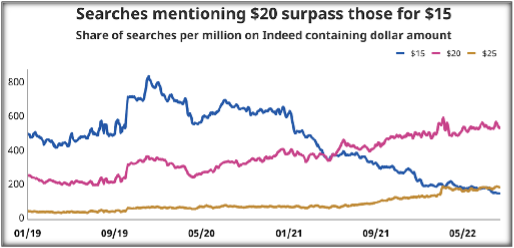
It’s no secret the past several years have been hard on employees and employers alike.
As a global increase in inflation continues – due to factors such as the economic fallout from the pandemic, supply chain issues, and impacts felt around the world by the Russian invasion of Ukraine – many fear the worst as it relates to unemployment. However, even if a recession hits – which is looking more likely – it’s not all doom and gloom for the labor market.
What are the chances of a recession?
During the recent Indeed ‘FutureWorks’ conference that several Source2 team members attended, Indeed’s Chief Economist Svenja Gudell as well as Senior Economist Daniel Culbertson presented on economic trends to watch. “The Federal Reserve is still trying to provide a ‘soft landing’ to drive down inflation while not ensuring unemployment explodes,” Gudell stated. “The tricky task is to attempt to cool growth. The chances of that ‘soft landing’ are dwindling. Inflation remains high, and the labor market is very strong.” Culbertson added, “Recessions come in many varieties and aren’t always a deep recession. A short and shallow recession that doesn’t cause too much trouble is certainly a possibility.”
Winners and losers
Recessions often result in declining economic activity, and since labor is one of the main drivers of the economy, it stands to reason that available jobs will also decrease. However, not all industries are feeling the squeeze. Those on the receiving end of the earmarked dollars passed as part of last year’s Infrastructure Investment and Jobs Act – such as heavy construction, utilities, engineering, and infrastructure industries – are finding the pitfalls of a tightening labor pool still very much a reality. As a variety of factors collide – from Baby Boomers retiring, to the Great Resignation and Renegotiation, and employees indicating they’d like to work from home – there’s a shrinking pipeline of workers to fill available jobs now and in the future.
Busier than ever
Recent labor market data indicates it’s not time to let up on efforts to drive recruitment and retention. Data shared from the Indeed ‘FutureWorks’ conference in mid-October as well as a recent Glassdoor report on employer branding indicated:
- A tight labor supply will continue to impact hiring, and in a similar vein, higher compensation is at the top of all workers’ minds due to rising inflation. As many HR professional can attest, “$20 has become the new $15” with respect to entry level wage rate expectations among many candidates as the following graph indicates:

- As workers seek higher pay, benefits can set employers apart. Fair pay and flexibility are requirements but are not enough to retain talent.
- Remote work is here to stay. Not surprisingly, remote job searches are outpacing pre-pandemic levels.
- Workplace transparency – open, honest, two-way dialogue with leadership – is critical to employee satisfaction and retention.
The aforementioned report from Glassdoor reports that 58% of the most satisfied employees are either searching for or open to a new job if the right opportunity comes along. And according to Indeed, as many as 85% of job seekers are looking for jobs outside their current field.

Employers would be wise to focus on efforts that drive a human connection between themselves and talent… both current and prospective. It's also time that employers begin to break down bias and barriers in hiring. One example of this type of effort is 'fair chance hiring,' built on the premise that everyone deserves fair consideration for jobs. With 77 million people in the U.S. having some sort of criminal record – comprising one-third of working citizens – and so many available jobs in heavy construction, utilities, engineering, and infrastructure expected to hit the market within the next decade, there is a major shift happening toward finding and training the right talent.
Conclusion
Turn on the TV or open a newspaper (or website), and it’s clear the global economy is on the brink of a recession. And while that word is often associated with mass layoffs, for some industries, there are no signs that a slowdown is on the horizon. In fact, just the opposite seems to be true for employers in industries that were bolstered by the Infrastructure Investment and Jobs Act. Employers looking to add talent should pay attention to the trends affecting the market in this economy, including what job seekers are looking for in terms of compensation, workplace, transparency, flexibility, and other job benefits.
Stay tuned for an upcoming Source2 blog that will detail the intangible benefits job seekers are demanding in a post Great Renegotiation market. If you’d like to discuss your company’s labor challenges, connect with our executive team by emailing us at solutions@source2.com or by completing our contact form.

Nov 15, 2022 9:33:16 AM



